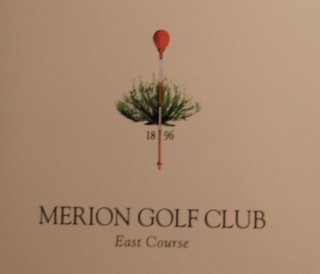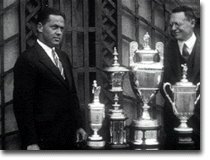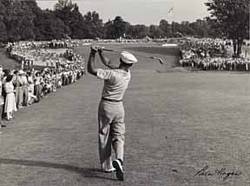
Seminole Golf Club (ranked #22 in the world) is located just north of Palm Beach, Florida in the town of Juno Beach. In the interest of full disclosure, I have never been a big fan of Florida golf. I find Bermuda grass difficult to play on, and the flat terrain in Florida, coupled with the omnipresent water hazards, have never left me enamored of golf in the Sunshine State. I was able to play Seminole this past winter and my expectations were high, as they should be when playing a course consistently ranked in the top 25 in the world.
HistorySeminole, founded by E.F. Hutton, has a rich history of being a golf club for the corporate elite. Donald Ross designed it in 1929. Seminole’s history runs deep. The course has hosted kings and presidents: Eisenhower was an honorary member; Ford and JFK played it often; and the Duke of Windsor was a member. To give a sense of the level of prominence of its membership, in 1947 members included Joseph P. Kennedy, Henry Ford II, Jack Chrysler, Paul Mellon, Phillip Armour, John Pillsbury and Robert Vanderbilt. Seminole’s membership has always included titans of industry, politics and golf. Henry Picard, the 1938 Masters winner, was the professional at Seminole for 26 years and Ben Hogan spent a significant amount of time here playing and practicing.
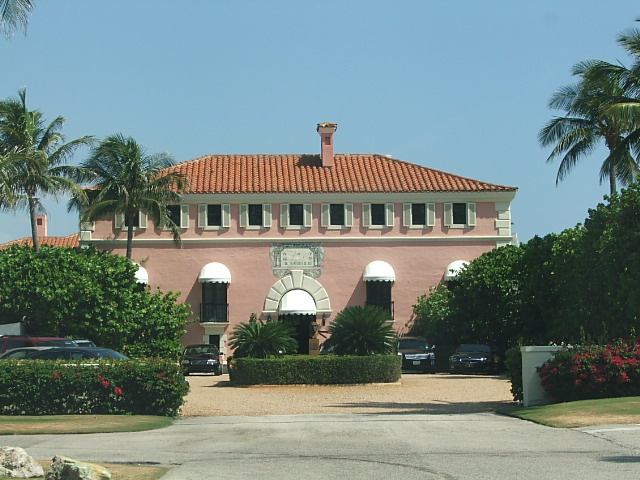
Seminole's Clubhouse
ArrivalArriving at Seminole, you feel like royalty. It is a golfer’s equivalent of being king (or queen) for a day. It has all the buildup and regalia of the State Opening of Parliament. This annual ritual is full of pageantry and pomp, as is arriving at Seminole. During the State Opening, the Queen arrives in her gilded carriage, while at Seminole we arrived in a rented PT Cruiser. Although she does not have to have her credentials checked to make the royal procession, we did our requisite stop at the front guard gate. Her ride is from Buckingham to Westminster, ours was down Seminole Blvd, the long entry road lined on the left with high bushes, which ensures Seminole’s privacy. At the end of the road, we made a sharp left through the hedges and turned into the club with the beautifully proportioned pink stucco clubhouse in front of us.
The drive in is enticing, because you can catch glimpses of the golf course through the hedges occasionally, raising your sense of anticipation. The Queen’s footmen help her dismount when she reaches Parliament. At Seminole, you drive into the gravel rock courtyard, and while you don’t have to dismount, you are greeted by a staff member who takes your clubs and parks your car. Since Her Majesty brings along her own cavalry, she is let in without hassle. We had to stop and check in again at the clubhouse foyer. She then walks up the steps to Parliament under a covered portico. After checking in, the golfer has the privilege of walking up an enclosed covered stairway through the Spanish style clubhouse, leading to the second level.
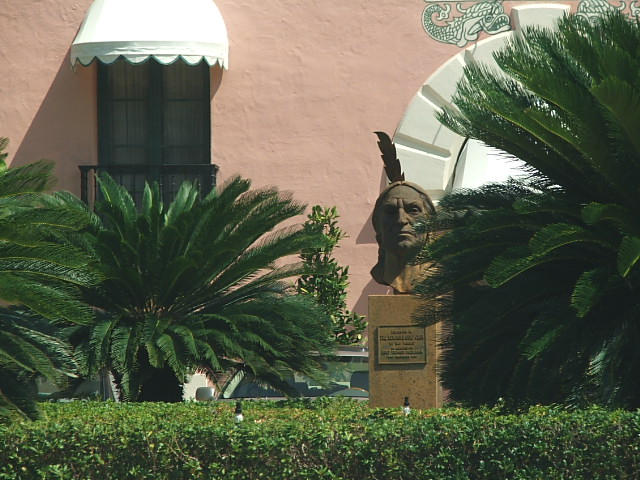
When you re-emerge in sunlight, a short walk leads you past what must be the least used swimming pool in America, situated right next to the clubhouse. The Sovereign proceeds through a series of corridors to approach The Lords Chamber. Your final turn down the walkway brings you into the locker room. Just as the House of Lords is the apex of parliamentary chambers, the Seminole locker room is equally as revered and respected. It is one of the most exciting golf clubs in the world to arrive at. The only things missing on our arrival were the trumpeters and beefeaters, although we would have our share of the latter after the round.
The Locker RoomThe massive locker room is double-height and has a beautiful Cypress-beamed ceiling. Around the top of the room are animal-head hunting trophies and wooden boards listing the names of past champions. The room is ringed with polished pine lockers, and there is a big fireplace at one end of the room. There is a bar at the far end of the room and comfortable seating throughout. Enter the locker room here and you begin to see why Seminole is one of America’s hallowed golfing grounds that commands reverential treatment. It is one of only a handful of places in America where you get this feeling. The others are Oakmont, Merion, Chicago, Baltusrol, Winged Foot and Shinnecock (my educated guess is Augusta and Cypress are as well, but I haven’t played them yet).
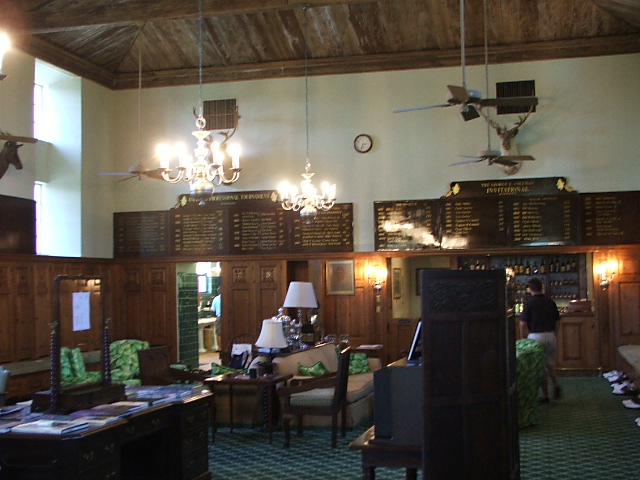
Seminole Locker Room
The names on the boards around the locker room are a who’s who of golf history – Snead, Nelson, Palmer, Els, with an occasional celebrity name thrown in such as Sean Connery. This is a function of an annual Amateur-Professional tournament that Seminole hosts each year (The Coleman) where an amateur is teamed with a professional. It sounds like one hell of a tournament and as the names on the boards attest, it attracts some of the best in the world at both the amateur and pro level.
The Layout and Routing
I had not heard universal praise about Seminole prior to my visit. The thing I heard often about Seminole from those who have played it was: Great locker room, but the course is mediocre. On the other end of the spectrum, the éminence grise of golf architecture critique, Tom Doak, uses some of his strongest language in his Confidential Guide when he warns the reader “… if anybody tries to tell you it isn't a great course, either they've been treated like riffraff, or they don't know what good is.”
So which is it: Is Seminole over-rated or does the riffraff factor come into play? Is the locker room better than the course?
The course is set on sand ridges near the Atlantic Ocean and has changed very little since Ross designed it. Dick Wilson made some changes after the Second World War and Brian Silva restored the bunkers more recently. The course is built between high dunes along the Atlantic and an inland set of dunes along the back of the property that are about forty feet high. At the time the course was built, the marshland between the dunes was drained to create a compact area for Ross to build the course. What you see is what you get at Seminole. Standing on the first tee, you can more-or-less see all eighteen holes. Ross made economical use of the small piece of land to build the golf course. There are very short walks tee to green and very few trees.
Although the course is right along the Atlantic, it only has water views in a limited number of places, which tells you something about the height of the sand dunes. You can see water off the 12th tee, 13th green, 14th tee and only in a couple of other places. The front nine is away from the water and the back nearer the water. It is a classic links layout of two loops of nine. The front nine run counter-clockwise from the clubhouse and the back nine run clockwise and finish parallel to the ocean.
The course is not lush, does not have beautiful landscaping and is not over-watered. It is wide open and plays firm and fast, like a classic links course. To appreciate Seminole you have to look beyond the conditioning and see the artfulness of its design.
The Golf Course
The first hole, as is standard on Ross designs, is a relatively easy hole to start the round. You pay for this easy start on the second hole, which has a forced carry over water. The golfer’s second shot is to an elevated green that is tilted and repels balls. As I was to learn, this is one of the essential elements of Seminole: Fast, elevated greens that are hard to hold unless you hit the perfect shot.
Rees Jones, who is a member, says in the club history, “Seminole is probably the best bunkered course in America. A shot that hasn’t hit the proper portion of the green is likely to wind up in one of the greenside bunkers.” The crowned greens that are Ross’s signature at Pinehurst are also present here, but not as pronounced, which in some ways make them more difficult. It is a very subtle design that fools the golfer into thinking they can attack pins.

2nd green
The third hole, a par five of 504 yards, is a dogleg right. It also plays uphill to a green that is tilted front to back.

4th green
The fourth hole, a 450 yard par four is the #1 handicap hole at Seminole. Your long second shot is to an oblong narrow green that is crowned and tilts to the side. Welcome to Seminole!
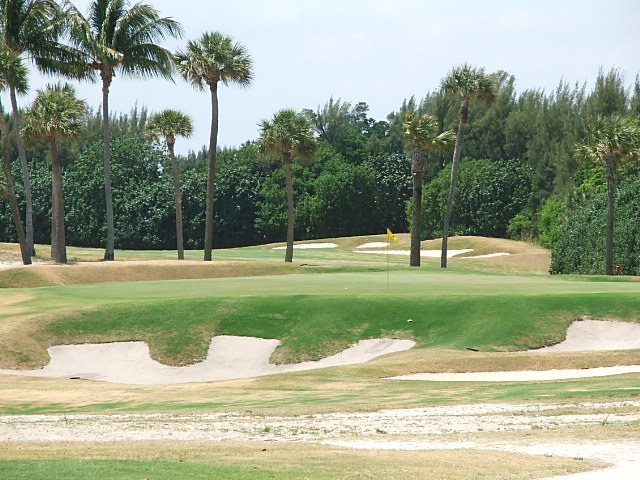
Par three 5th green
Ben Hogan, who was a member, used to practice at Seminole during the month of March each year, in anticipation of playing at The Masters. Hogan's favorite hole was the 6th. A short par four at 388 yards and a slight dogleg to the left, it plays to an elevated, well bunkered-green. Apparently, Hogan used to play the hole by hitting a draw tee shot and a cut into the green. I was happy with my two straight shots and a par.
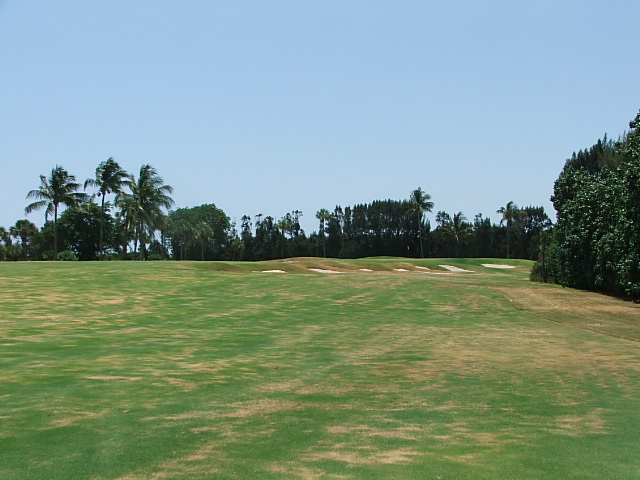
6th fairway from the tee

6th green
The course winds its way back to the clubhouse at #9. The first few holes on the back are delightfully similar to the first several holes on the front, but looping in the opposite direction. Eleven is a difficult hole and is one of my favorites. It is a par four of 420 yards with a forced carry over water off the tee. The second shot is up-hill to a green that slopes front to back and left to right severely. Putting off this green is not uncommon.
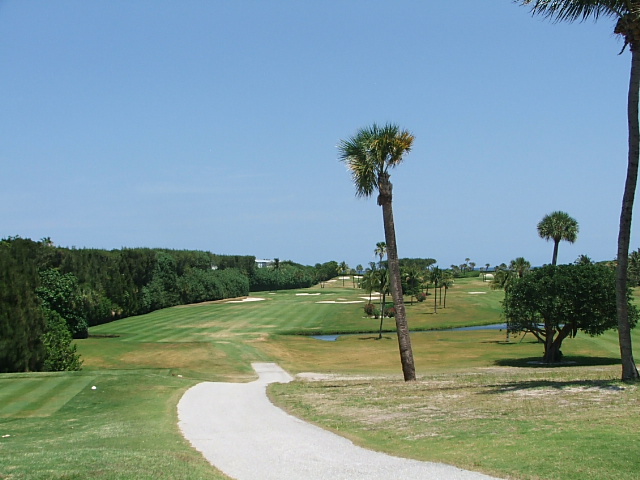
12th hole from the tee
Twelve was my favorite hole. A 367 par four that plays from an elevated tee box into a prevailing wind with a hedgerow down the entire left side. The green is the best bunkered on the course and is tilted sideways and oblong, making for a very narrow landing area. Even though you are hitting a short iron, the green looks so small and un-receptive that it is very hard to hit.

13th green
Thirteen is a beautiful up-hill par three nestled within the dunes, with the Atlantic Ocean behind.
The par five fifteenth is Arnold Palmer’s favorite hole. It is a 497 yard hole and asks the player to hit risk-reward shots twice. The first decision off the tee is how much of the lake to cut off on your tee shot. The dogleg runs to the right, so if you hit far enough right you have a shot at going for the green in two. The safer play is to the left and a pussy shot is to play the alternate fairway, which is far left behind a row of palm trees, but well away from the water. Your second shot is again over water, so you have two forced carries in a row. The green is elevated, well-bunkered and fast. Like all the greens at Seminole, it repels shots that are not hit perfectly.
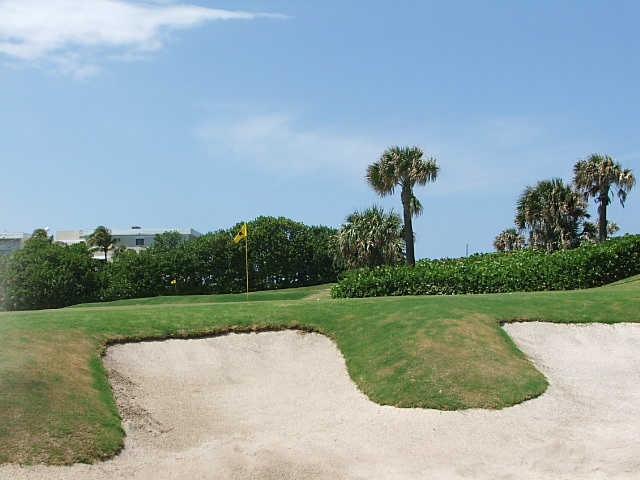
16th green
Seventeen and eighteen parallel the Atlantic Ocean, and the prevailing wind is off the ocean. The eighteenth must be an impossible hole in a strong wind. The 417 yard par four is a dogleg left and has a fairway that slopes uphill and at an angle toward the beach. If the wind is blowing, you have to hit your shot over the sand dunes along the ocean and hope the wind blows it back to the correct spot on the small fairway. Architect Brian Silva, who restored the bunkers at Seminole, describes it perfectly: “the strongest feature of the golf course is its angles in relation to the wind.” The eighteenth is the perfect example of this. Although it looks relatively benign when you see the routing on paper, in reality it is very difficult. These subtleties make Ross’s design such a treat. The way the fairway is shaped is counter to the way the wind blows.
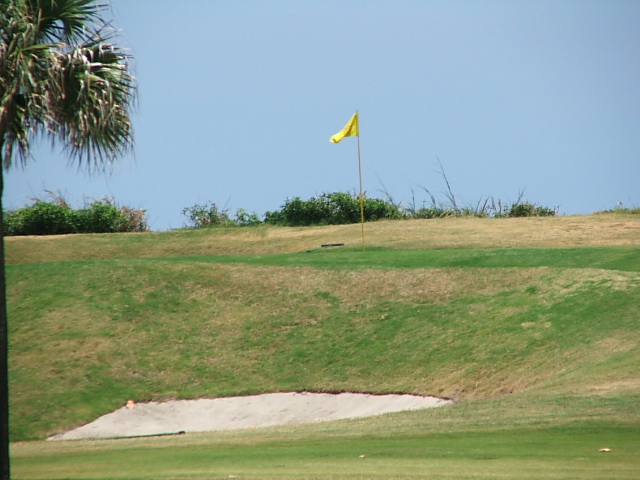
18th green from the side
Seminole is the exception to typical Florida golf. Although you have to look beyond the conditioning and wide open feel, if you judge it like a links course that plays firm and fast, you will appreciate that it is a great course. The elevation changes make it interesting, as do the difficult to hold crowned and tilted greens. The fact is, it has a great routing and is one of the best risk/reward courses ever built.
In many ways, I liken Seminole to The Old Course at St. Andrews and Shinnecock, both of which do not bowl you over upon first sight. Their greatness is in their subtlety, variety and the degree to which the course changes depending upon the wind direction and speed.
 Seminole Locker Room
Seminole Locker Room
The Club
Despite my tattoo, cutoff shorts, surly manner and earring, I was treated well at Seminole and liked the course. Seminole has figured out how to be respectful of the past without being stuffy. They are on the right side of that fine line between guarding their privacy and being pricks or impressed with themselves. The attitude of everyone at the club was the same – friendly and accommodating. The caddies were the best I have personally seen in the United States. Seminole is upper crust without being uptight.
Seminole is a private club with a high percentage of members who do not live locally and has many similarities to Augusta National. It is only open from November through May. Consistent with its history, many of Seminole's members are of the corporate elite. It is one of those clubs that is coveted by the select group of über-golfers who collect high-end golf clubs in the same way your average golfer might collect balls or scorecards. Five ex-USGA presidents are members. I found it amazing that Hogan played there until 1980 – members still recount first hand playing with him.
Strictly speaking, Seminole has a great locker room – although it really is more of a combination of a locker room and bar. While it is world class, I personally think the locker room at San Francisco Golf Club and the clubhouse sitting area at Garden City Mens Club are just as good.
Does the overall atmosphere, exclusivity and the locker room influence Seminole's place in the world rankings? You would be naïve to think differently. So the course might be a tad over-rated, but when you throw in the whole package, it remains one of golf's standard-bearer’s. As Doak says, it is one of golf's aristocrats.



